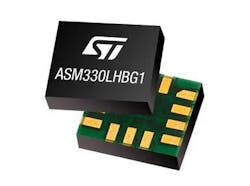Inertial Modules Equipped to Handle Functional Safety Up to ASIL B
ASIL functional safety and relay races have some interesting elements in common. Both depend on getting timing down at each stage and having smooth handoffs throughout. When a mistake is made a runner can stop and pick up a dropped baton; similarly, malfunctioning behavior of electronic systems can be fixed when first silicon doesn't perform correctly. Unfortunately, either miscue also means you won't be standing on the winner's podium.
On that front, STMicroelectronics developed the ASM330LHBG1 6-axis inertial measurement unit (IMU), which is AEC-Q100 Grade-1 qualified for automotive applications. Offering ASIL B compliance if used with a certified software library, it features a 3-axis digital accelerometer and a 3-axis digital gyroscope.
For ASIL B applications, the device requires two identical IMUs. The reason for having a module composed of two identical sensors is to implement redundancy mechanisms, checking that the data coming from two different sensing sources is consistent.
According to ST, the ASM330LHBG1 can withstand environments with an extended operating temperature range of up to 125°C. Thus, it’s well-suited for use around the engine compartment and in areas exposed to direct sunlight.
The ASIL B library interfaces a sensing module, consisting of the two IMUs, with a host processor. Interfacing the module entails configuring the sensing module, checking the sensing module before starting to acquire data, and acquiring the data coming from the sensing module. Each of these steps is associated to an error code, warning the user of the improper function of the module.
The modules are applied to systems such as vehicle navigation (for precise positioning), support for body electronics, digitally stabilizing cameras, LiDARs, and radars, active suspension, door modules, vehicle-to-everything (V2X) applications, and adaptive lighting.
Software Library Focuses on ASIL B
A safety manual and a software library, certified according to ISO 26262:2018, are provided to support the development of applications using the ASM330LHBG1 and targeting ASIL B requirements. This library offers information about the linear accelerations and angular rates of the vehicle. It’s platform-independent and can be customized according to the user's target microcontroller.
ST compiles the libraries based on design requirements obtained from an online registration form. It provides embedded software testing guidelines as well as integration manuals and release notes to the user.
The independently tested and certified software adheres to ISO 26262 and enables safety-compliant redundancy with two ASM330LHBG1 modules. Fulfilling safety element out of context (SEooC), this combination is based on general-purpose hardware and supports system certification up to ASIL B.
Micromachining and MEMS
ST’s family of MEMS sensor modules leverages the manufacturing processes it already uses for the production of micromachined accelerometers and gyroscopes to serve both the automotive and consumer market. The sensing elements are manufactured with the company’s proprietary micromachining processes. And the the IC interfaces are developed using CMOS technology that allows for the design of a dedicated circuit, which is trimmed to better match the characteristics of the sensing element.
The AEC-Q100-compliant part is industrialized through a dedicated MEMS production flow to meet automotive reliability standards. All parts are said to be fully tested with respect to temperature to ensure the highest-quality level.
The ASM330LHBG1 has a full-scale acceleration range of ±2/±4/±8/±16 g and a wide angular rate range of ±125/±250/±500/±1000/±2000/±4000 dps, which enables its usage in a broad range of automotive applications. The device also supports dual operating modes: high-performance mode and low-power mode.
The modules contain embedded temperature compensation, which ensures stability over wide-ranging operating conditions, and provides a six-channel synchronized output to enhance the accuracy of dead-reckoning algorithms. In addition, I2C, MIPI I3C, and SPI serial interfaces, smart programmable interrupts, and a 3KB FIFO ease managing sensor data to minimize load on the host processor.
Event-detection interrupts enable motion-activated functions, implementing hardware recognition of free-fall events, 6D orientation, activity or inactivity, and wake-up events.
Equipped with ST’s machine-learning core (MLC) and programmable finite state machine (FSM), the ASM330LHBG1 can run artificial-intelligence (AI) algorithms in the sensor to provide smart functionality at low power. The IMU is pin-to-pin compatible and shares the same configuration of registers as ST’s automotive IMUs with a lower operating-temperature range, permitting an easy upgrade.
Adapter Board Speeds Evaluation, Prototyping
ST also offers the STEVAL-MKI244A, an adapter board designed to facilitate the evaluation of MEMS devices in the ASM330LHBG1 product family. The board enables fast system prototyping and device evaluation directly within the user’s own application.
The STEVAL-MKI244A can be plugged into a standard DIL24 socket. The adapter provides the complete ASM330LHBG1 pinout and comes ready-to-use with the required decoupling capacitors on the VDD and VDDIO power-supply lines.
This adapter is supported by a STEVAL-MKI109V3 motherboard, which includes a 32-bit microcontroller functioning as a bridge between the sensor and a PC. It’s possible to use the downloadable graphical user interface (MEMS studio) or dedicated software routines for customized applications.
The ASM330LHBG1, in production now, comes in a 14-lead, 2.5- × 3-mm VFLGA plastic land-grid-array package. Pricing is $9.40 for orders of 1,000 pieces.

